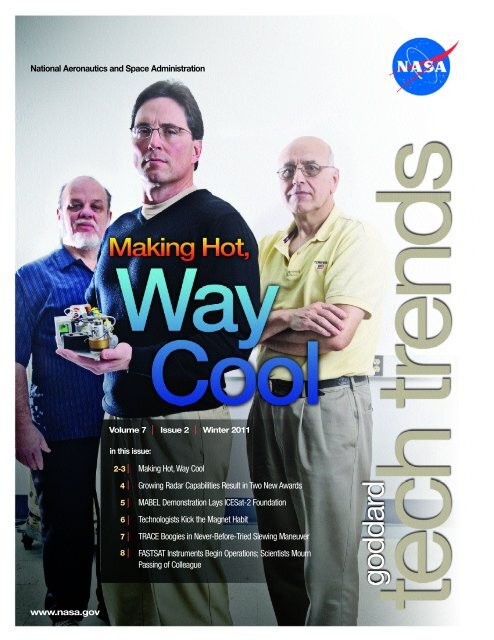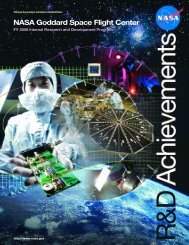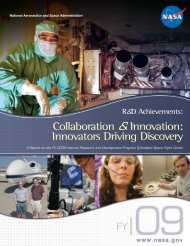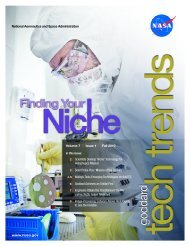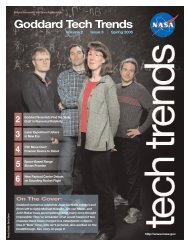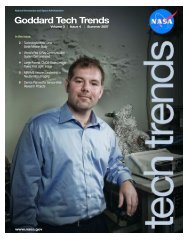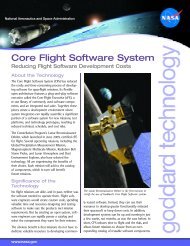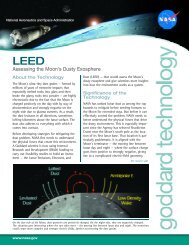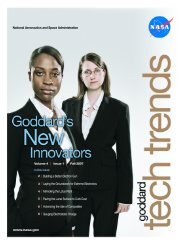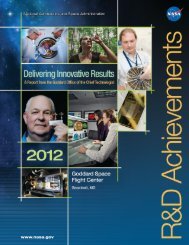Winter 2011 - NASA's Goddard Technology Management Office Home
Winter 2011 - NASA's Goddard Technology Management Office Home
Winter 2011 - NASA's Goddard Technology Management Office Home
You also want an ePaper? Increase the reach of your titles
YUMPU automatically turns print PDFs into web optimized ePapers that Google loves.
National Aeronautics and Space Administration<br />
Volume 7 Issue 2 <strong>Winter</strong> <strong>2011</strong><br />
in this issue:<br />
2 - 3<br />
4<br />
5<br />
6<br />
7<br />
8<br />
Making Hot, Way Cool<br />
G r owing Radar Capabilities Result in Two New A w a r d s<br />
MABEL Demonstration Lays ICESat-2 Fo u n d at i o n<br />
Technologists Kick the Magnet Habit<br />
TRACE Boogies in Never- B e f o r e - Tried Slewing Maneuver<br />
FA S T S AT Instruments Begin Operations; Scientists Mourn<br />
Passing of Colleag u e<br />
w w w. n a s a . g o v
02<br />
Making Hot, Way Cool<br />
New Thermal-Control <strong>Technology</strong> to be Demonstrated this Spring<br />
The more advanced the electronics, the more<br />
power they use. The more power they use, the<br />
hotter they get. The hotter they get, the more<br />
l i kely they’ll overheat. It doesn’t take a rocke t<br />
scientist to understand what typically happens<br />
next: The electronics fry.<br />
To quote <strong>Goddard</strong> thermal engineer Jeff<br />
Didion, “In the world of electronics, therm a l<br />
control is always one of the limiting factors.”<br />
H o w e v e r, he and his team have collaborated<br />
with various <strong>Goddard</strong> engineering disciplines,<br />
the National Renewable Energy Laboratory<br />
(NREL), and the U.S. Air Force to create a technology<br />
that overcomes the limitations. Already<br />
proven in laboratory tests that it works for long<br />
periods of time, the technology will be tested<br />
for the first time aboard a sounding rocket mission<br />
from the Wallops Flight Facility (T e c h<br />
T r e n d s, Fall 2010, Page 4) this spring.<br />
Called electrohydrodynamic (EHD)-based thermal<br />
control, the technology promises to make<br />
it easier and more efficient to remove heat<br />
from small spaces, vastly expanding the capabilities<br />
of advanced instruments and microprocessors.<br />
“To d a y, higher-power chips are<br />
available, but they generate too much heat,”<br />
Didion said. “If I can carry away more heat,<br />
engineers will be able to use higher- p o w e r<br />
components. In other words, they will be able<br />
to do more things.”<br />
No Moving Parts<br />
U n l i ke traditional single-phase therm a l - c o n t r o l<br />
technologies that rely on mechanical pumps<br />
and other moving parts, EHD cooling uses electric fields<br />
to pump coolant through tiny ducts inside a thermal cold<br />
plate. From there, the waste heat is dumped into a radiator<br />
and dispersed far from heat-sensitive circuitry that<br />
must operate within certain temperature ranges. Its<br />
architecture, therefore, is relatively straightforw a r d .<br />
Technologist Jeff Didion and his team have developed a new therm a l - c o n t ro l<br />
technology that uses electric fields rather than mechanical parts to pump<br />
coolant through tiny ducts inside a thermal cold plate. A prototype pump<br />
(bottom) will be inserted into an experiment (top) that will fly as one of several<br />
payloads aboard a Te r r i e r- I m p roved Orion sounding rocket from the Wa l l o p s<br />
Flight Facility this spring.<br />
About the Cover:<br />
Electrodes apply the voltage that pushes the coolant<br />
through the ducts.<br />
The advantages are many. EHD-based systems are lightweight<br />
and consume little power, roughly half a watt.<br />
Jeff Didion (center), Matthew Showalter (left), and Mario Martins (right) are leveraging<br />
their respective talents to develop a new thermal-control technology. In this image, Didion<br />
holds an experiment that will fly on a sounding rocket this spring to determine whether<br />
the technology, in particular a prototype pump (pictured above), can withstand the severe<br />
launch loads as the sounding rocket lifts off and hurtles toward space. A successful<br />
demonstration will advance the pump to a technology-readiness level of seven.<br />
C o n t i n u e d , Page 3<br />
Photo Credit: Chris Gunn<br />
h t t p : / / g s f c t e c h n o l o g y. g s f c . n a s a . g o v Volume 7 Issue 2 <strong>Winter</strong> <strong>2011</strong>
H o t. . . Continued from page 2<br />
Fu rt h e rmore, they are easily controlled.<br />
The application of a specific voltage creates<br />
the appropriate electric field that<br />
moves the coolant. But perhaps more<br />
i m p o rt a n t l y, the system can be scaled to<br />
different sizes, from macro-scale stru c t u r a l<br />
cold plates to micro-scale electronic components<br />
and lab-on-a-chip devices.<br />
03<br />
“EHD makes thermal control simpler, ”<br />
said Tom Flatley, a technologist who is<br />
advancing the <strong>Goddard</strong>-developed<br />
SpaceCube processor, a next-generation<br />
technology that is 25 times faster than the<br />
c u rrent state-of- t h e - a rt flight processor. It<br />
is just one of several technologies that<br />
could benefit from the system’s continued<br />
development.<br />
“Any electronic device that generates a lot<br />
of heat is going to benefit from this techn<br />
o l o g y,” said Ted Swanson, assistant chief<br />
for technology for the Mechanical Systems Division. This<br />
would include everything from sensors flown in space to<br />
those used in automobiles and aircraft .<br />
In development for more than a decade, Didion concedes<br />
the concept is not new. He and Jamal Seyed-<br />
Yagoobi, a professor at the Illinois Institute of<br />
Te c h n o l o g y, have collaborated for more than a decade<br />
on EHD-based pumps, proving in a laboratory environment<br />
that they work for extended periods. What’s new is<br />
that he and his team, including Matthew Showalter, associate<br />
head of the Advanced Manufacturing Branch, and<br />
Mario Martins, an Edge Space Systems employee, are<br />
leveraging their respective talents to develop systems<br />
that can fly in space. “We’re taking a concept and making<br />
it an operational prototype for spacecraft applications,”<br />
Didion said.<br />
Flight Demonstrations Scheduled<br />
A prototype EHD pump will be demonstrated this spring<br />
when it flies as one of several experiments aboard a<br />
Te rr i e r-Improved Orion sounding rocket from Wa l l o p s .<br />
The main objective is demonstrating that the technology<br />
can withstand the extreme launch loads as the rocke t<br />
l i fts off and hurtles toward space. Should it survive the<br />
vibration, the technology will have achieved a technology<br />
readiness level of seven, meaning it’s at or near operational<br />
status — a major milestone for any emerging<br />
space technology.<br />
But Didion and his team don’t intend to stop there. Wi t h<br />
s u p p o rt from <strong>Goddard</strong>’s Internal Research and<br />
Development program, the Air Force, NREL, and others,<br />
the team is experimenting with composite materials and<br />
This is a bre a d b o a rd device to prove the concept of using electro h y d ro d y n a m i c -<br />
based therm a l - c o n t rol techniques for micro-scale applications.<br />
special micro-fabrication techniques and coatings to create<br />
smaller, more robust thermal-control units.<br />
Applications abound. These multifunctional devices could<br />
be used as stand-alone, off-the-shelf components ideal for<br />
q u i c k - t u rnaround spacecraft — a capability that part i c u l a r-<br />
ly interests the Air Force. In fact, the Air Force plans to<br />
demonstrate a modular, 12-inch square therm a l - c o n t r o l<br />
plate during an upcoming flight.<br />
The technology also could be embedded within the walls<br />
of the electronic device itself. Flatley will test the viability<br />
of an embedded unit during a SpaceCube experiment<br />
called ISE 2.0 flying on the International Space Station in<br />
2013. “He’s working in stages,” Flatley said. “The next step<br />
would be to get the technology on circuit cards.” The ultimate<br />
goal, however, is to scale the technology to the chip<br />
level where the ducts would be no larger than 100<br />
microns, or ten-thousandths the width of a human hair.<br />
“The point is that you want to place the therm a l - c o n t r o l<br />
unit closer to the source of heat, which, of course, is a lot<br />
more efficient at eliminating waste heat,” Flatley said.<br />
The future looks promising, Swanson said. “Jeff has come<br />
up with a way to push single-phase fluids around to get<br />
rid of heat. He’s demonstrated that it can work for long<br />
periods of time. He’s out there partnering with expert s<br />
here at <strong>Goddard</strong> and those from other institutions. He’s<br />
doing the proverbial ‘look under every rock and around<br />
e v e ry corn e r’ in an attempt to advance this technology. In<br />
technology R&D, this is the model approach.” <br />
C o n t a c t :<br />
J e f f r e y. R.Didion@nasa.gov or 301.286.4363<br />
Volume 7 Issue 2 <strong>Winter</strong> <strong>2011</strong><br />
h t t p : / / g s f c t e c h n o l o g y. g s f c . n a s a . g o v
04<br />
G o d d a r d ’s Growing Radar Capabilities Recognized in Tw o<br />
New Aw a r d s<br />
Five years of investment and an important part n e r-<br />
ship with a world-renowned leader in radar technology<br />
have resulted in <strong>Goddard</strong> winning nearly<br />
$9 million in new NASA funding to further advance<br />
two first-of-a-kind radar instruments suited for<br />
next-generation Earth science missions — evidence<br />
of the center’s growing capabilities in radarbased<br />
observation techniques.<br />
Under NASA’s Instrument Incubator Program (IIP)<br />
managed by the Earth Science <strong>Technology</strong> <strong>Office</strong>,<br />
the Agency awarded Principal Investigators Lola<br />
Fatoyinbo and Paul Racette $4.3 million and $4.5<br />
million, respectively, to advance radar instru m e n t s<br />
in support of the proposed Deform a t i o n ,<br />
Ecosystem Structure and Dynamics of Ice<br />
(DESDynI) and Aerosol-Cloud-Ecosystems (AC E )<br />
missions. The National Research Council recommended<br />
both in its first-ever Decadal Survey of future Eart h -<br />
o b s e rving missions in 2007. They, like many of the other<br />
15 recommended missions, call for measurements that<br />
could be obtained with radar-based technologies.<br />
The awards were seen as evidence of <strong>Goddard</strong>’s wisdom<br />
in both investing more R&D resources into radar technologies<br />
and establishing a Space Act Agreement with<br />
N o rthrop Grumman Electronic Systems (NGES), a wellknown<br />
leader in military-based radar systems (T e c h<br />
T r e n d s, Spring 2008, Page 8). Although <strong>Goddard</strong> has for<br />
years developed aircraft - b o rne radar instruments to validate<br />
data collected by Eart h - o b s e rving satellites, the center<br />
has never been considered a radar powerhouse.<br />
“You have to have a long-term plan<br />
and a long-term vision,” said Bob<br />
C o n n e rton, chief engineer of<br />
<strong>Goddard</strong>’s Earth Sciences Division,<br />
r e f e rring to the center’s growing<br />
investment in radar technologies.<br />
“Then you have to stick to it. Yo u ’ r e<br />
now seeing the fruit of a five-year<br />
e f f o rt. A lot of people said we’d never<br />
get there.”<br />
Unprecedented Capabilities<br />
This art i s t ’s rendition shows the data-gathering technique EcoSAR will<br />
employ to measure biomass.<br />
demonstrated on the NASA P-3 research aircraft in 2013,<br />
will derive these amounts by measuring biomass, forest<br />
height, density, and extent. “The idea is to close the gaps<br />
in the carbon cycle,” Rincon said. “With our instru m e n t ,<br />
you’ll get a better assessment on how much biomass<br />
there is, which is hard to measure globally. ”<br />
EcoSAR traces its heritage to Rincon’s L-Band Digital<br />
B e a m f o rming Synthetic Aperture, which he and his team<br />
developed with <strong>Goddard</strong> R&D funding. This technology<br />
demonstrated for the first time the ability to simultaneously<br />
synthesize and process multiple radar beams and<br />
produce high-resolution data over larger areas. In contrast,<br />
conventional radar systems gather high-resolution<br />
data only along a narrow swath.<br />
C o n t i n u e d , Page 5<br />
Fatoyinbo and <strong>Goddard</strong> engineer<br />
Rafael Rincon will use the funding to<br />
f u rther mature key components for an<br />
i n s t rument called EcoSAR, which will<br />
help close the gaps in scientists’<br />
understanding of the carbon cycle.<br />
Although forests store about 85 percent<br />
of terrestrial carbon, the exact<br />
amount of carbon currently is<br />
unknown. EcoSAR, which will be<br />
Technologist Paul Racette, who is working with Nort h rop Grumman Electronic Systems on<br />
advanced antenna technologies that could enable the proposed ACE mission, is checking<br />
the fit of a waveguide for the Cloud Radar System antenna.<br />
h t t p : / / g s f c t e c h n o l o g y. g s f c . n a s a . g o v Volume 7 Issue 2 <strong>Winter</strong> <strong>2011</strong>
R a d a r. . . Continued from page 4<br />
EcoSAR adapts the same general approach, but focuses<br />
on the P-Band (435 MHz), a lower microwave frequency<br />
that can pierce forest canopies to obtain unprecedented<br />
two- and three-dimensional fine-scale measurements of<br />
biomass — a measurement directly traceable to the<br />
anticipated DESDynI mission. “It was really great getting<br />
that award,” Fatoyinbo said. “With this instrument, we<br />
will get measurements we were never able to acquire<br />
b e f o r e . ”<br />
Novel Dual-Frequency Doppler<br />
Racette and NGES, meanwhile, received funding to<br />
advance antenna technologies for a novel dual-frequency<br />
Doppler radar that provides fixed-beam operation at W-<br />
band and wide-swath imaging at Ka-band from a common<br />
aperture. By combining the W- and Ka-band antenna<br />
technologies, the team can develop a smaller, lighter,<br />
and lower-cost instrument to measure cloud profiles and<br />
reveal the role of aerosols in cloud development — one<br />
of ACE’s objectives. W-band measurements tell scientists<br />
what an ice cloud looks like along the line of sight, while<br />
Ka-band measurements tell “us what’s generating the ice<br />
cloud,” Racette explained. “Ice is a big unknown.”<br />
L i ke EcoSAR, Racette’s dual-frequency radar leverages<br />
previous R&D investments. Pa rt i c u l a r l y, he will apply<br />
advances made in “reflectarr a y” antennas and the W- b a n d<br />
technology <strong>Goddard</strong> developed to calibrate and validate<br />
CloudSat, launched in 2006 to study the role that clouds<br />
and aerosols play in regulating weather, climate, and air<br />
q u a l i t y. During the final year of his three-year program,<br />
Racette plans to demonstrate a scale model of the antenna<br />
during a suborbital flight.<br />
Although Racette and NGES have proposed other instrument<br />
concepts, this is the first to garner NASA support, he<br />
said. “We’re finally being recognized for our work, as<br />
evidenced by the IIP,” he said. “These awards are just<br />
the latest.” <br />
C o n t a c t :<br />
L o l a . Fatoyinbo@nasa.gov or 301.614.6660<br />
Rafael.Rincon@nasa.gov or 301.614.5725<br />
Pa u l . E . Racette@nasa.gov or 301.286.4756<br />
05<br />
MABEL Proves ICESat-2 Altimetry Approach<br />
<strong>Goddard</strong> Scientist Builds Proof-of-Concept Instrument in Just 12 Months<br />
In just 12 months, <strong>Goddard</strong> scientist<br />
Matt McGill and his team<br />
conceived, built, and then recentl<br />
y demonstrated a new instru m e n t<br />
that provides the foundation for<br />
the next-generation Ice Cloud<br />
and land Elevation Satellite-2<br />
(ICESat-2), scheduled for launch<br />
in January 2016.<br />
The successful five-day demonstration<br />
of the Multiple Altimeter<br />
Beam Experimental Lidar<br />
(MABEL) — a small, boxy instrument<br />
that developers had tucke d<br />
snugly inside the nose of NASA’ s<br />
high-altitude ER-2 aircraft — gathered surf a c e - e l e v a t i o n<br />
measurements from its vantage point 12 miles above the<br />
s o u t h w e s t e rn U.S. Its success proved that photon counting,<br />
a newer type of laser- a l t i m e t ry technique baselined<br />
for the mission, works at a high altitude and is suitable for<br />
ICESat-2.<br />
U n l i ke analog-laser altimetry, which uses analog detectors<br />
and digitizes the return signal, photon counting precisely<br />
records the time-of-flight of individual photons as they<br />
travel from the instrument, reflect off Eart h ’ s<br />
s u rface, and then are detected as they return to the<br />
i n s t rument. The technique, which McGill and his colleagues<br />
developed for such instruments as the Cloud<br />
Members of the MABEL team, Ryan Cargo, of Sigma<br />
Space Corporation, and Andrew Kupchock, of Science<br />
Systems and Applications, Inc., insert MABEL into the<br />
nose pod of the ER-2 airc r a f t .<br />
Physics Lidar, can resolve elevation<br />
differences to about two centimeters.<br />
When used on ICESat-2,<br />
the resolution will be 10 centimeters<br />
or better over most surf a c e s<br />
— an impressive feat from space.<br />
Also impressive is that it took<br />
McGill’s team just one year and<br />
$2 million to create the instrument,<br />
from concept to design,<br />
procurement, assembly, and the<br />
first successful flights from<br />
D ryden Flight Research Center<br />
late last year. Built in part n e r s h i p<br />
with Sigma Space Corporation,<br />
MABEL will never fly in space, but it will be used to validate<br />
ICESat-2 measurements when the spacecraft flies. In the<br />
nearer term, NASA plans to use it in conjunction with an<br />
IceBridge mission slated for this spring, McGill said.<br />
“Usually it takes three years under an Instru m e n t<br />
Incubator Program to develop a proof- o f-concept instrument.<br />
We condensed this down to a year,” McGill said.<br />
“ People broke their backs getting this done.” <br />
C o n t a c t :<br />
M a t t h e w.J.Mcgill@nasa.gov or 301.614.6281<br />
Volume 7 Issue 2 <strong>Winter</strong> <strong>2011</strong><br />
h t t p : / / g s f c t e c h n o l o g y. g s f c . n a s a . g o v
06<br />
Kicking the Magnet Habit<br />
Team Develops New Approach for Activating Microshutters<br />
<strong>Goddard</strong> technologists who created the<br />
microshutter assembly that will allow the<br />
James Webb Space Telescope’s Near Infrared<br />
Spectrograph (NIRSpec) to study 100 objects<br />
simultaneously have demonstrated a new<br />
approach for building the device — a development<br />
that could revolutionize an already<br />
groundbreaking observing technology.<br />
The group’s secret: It found a way “to get off<br />
the magnet,” said technologist Mary Li, who is<br />
working with astrophysicists Harvey Moseley<br />
and Alexander Kutyrev to advance the technolo<br />
g y. Though still in the early stages of development,<br />
the new technology could transform<br />
many future space missions, including the<br />
proposed Advanced <strong>Technology</strong> Large-<br />
A p e rture Space Telescope, a possible followon<br />
to the Webb observ a t o ry.<br />
Considered among the most innovative technologies flying<br />
on the Webb observ a t o ry, the microshutter assembly<br />
is created from micro-electro-mechanical (MEMS) technologies<br />
and comprises thousands of tiny shutters, each<br />
about the width of a human hair. Assembled on four<br />
postage stamp-sized grids or arrays, the 250,000 shutters<br />
open or close to allow only the light from targeted<br />
objects to enter the spectrograph, which helps identify<br />
types of stars and gases that make up galaxies and measure<br />
their distances and motions. Because Webb will<br />
o b s e rve faint, far-away objects, it will take as long as a<br />
week for NIRSpec to gather enough light to obtain a<br />
good spectrum.<br />
Therein lies the beauty of the microshutter technology. It<br />
will allow scientists to gather spectral data on 100 objects<br />
at a time, vastly increasing the observ a t o ry’s efficiency.<br />
Never before has NASA flown a technology in space that<br />
allows for multi-object spectroscopy.<br />
Though revolutionary, the current design has drawbacks,<br />
Li said. It relies on a motorized magnet that sweeps over<br />
the shutter arrays to activate them. “The magnet set-up<br />
adds weight,” Li explained. “The device also relies on<br />
mechanical parts that can break and the arrays can’t be<br />
sealed, which makes them vulnerable to particle contamination.”<br />
More troublesome, especially for next-generation<br />
o b s e rvatories requiring larger fields of view, the instrument<br />
would require a much larger magnet, which make s<br />
fabrication very difficult, she said.<br />
H o w e v e r, team members reasoned that if they could<br />
eliminate the magnet and motor, they could remove<br />
some of these potential challenges and, better yet, make<br />
a hermetically sealed microshutter array ideal for the<br />
spectral and imaging instruments of the future.<br />
Demonstrated Electrostatic Actuation<br />
With <strong>Goddard</strong> and NASA R&D funding, Li and other team<br />
members have set out to do just that. They altered a<br />
spare microshutter array and demonstrated that they<br />
could open selected shutters through electrostatic actuation.<br />
To do this, the team attached alternating curr e n t<br />
( AC) and direct current (DC) electrodes to the rows and<br />
columns of shutters. By applying a certain voltage to the<br />
electrodes attached to specific shutters, they created a<br />
vibration or resonance that allowed the selected shutters<br />
to swing open and then latch. To keep the shutters open,<br />
the team cut off the voltage on one axis. To close them,<br />
they cut off power on both.<br />
Although the group has demonstrated the viability of its<br />
design, the technology is far from flight ready. The challenge<br />
now is reducing the amount of voltage needed to<br />
open the shutters, Li said. During the demonstration, she<br />
and her team applied 84 volts of power to the DC electrodes<br />
and 84 volts to the AC — levels that would bust<br />
power budgets on a MEMS-based instrument. “We need<br />
to tweak the components to bring down those levels to<br />
30 volts,” Li said. However, she said, she’s optimistic<br />
because tweaking components to improve their<br />
p e rf o rmance is her team’s specialty.<br />
“I remember how long it took us to make the initial<br />
microshutter arr a y,” she said. “The good thing is we’ve<br />
already demonstrated electrostatic actuation. We know<br />
that electrostatic actuation is going to happen; it’s just a<br />
matter of when,” Li said. “We absolutely need to develop<br />
this technology. It’s ideal for imaging and spectroscopy<br />
across a good portion of the spectru m . ”<br />
C o n t a c t :<br />
Photo Credit:<br />
Chris Gunn<br />
Engineer Dan Kelly mounts a next-generation microshutter array in a vacuum<br />
chamber for testing. The insert shows a close-up view of the device, which is<br />
expected to revolutionize an already gro u n d b reaking observing technology.<br />
M a ry.J.Li@nasa.gov or 301.286.9921<br />
h t t p : / / g s f c t e c h n o l o g y. g s f c . n a s a . g o v Volume 7 Issue 2 <strong>Winter</strong> <strong>2011</strong>
Spacecraft Boogie<br />
Sun-Gazing Spacecraft Carries Out Never- B e f o r e - Tried Slewing Maneuver<br />
07<br />
The fastest path between Point A and<br />
Point B is a straight line. Not so fast,<br />
says a team of scientists and engineers<br />
who recently disproved this<br />
commonly accepted notion using a<br />
NASA satellite that was designed only<br />
to gaze at the Sun, not point in multiple<br />
directions.<br />
In what may seem counterintuitive<br />
even to engineers, a team from the<br />
Naval Postgraduate School (NPS),<br />
Draper Laboratory, and <strong>Goddard</strong><br />
proved that the spacecraft actually<br />
rotated faster to reach a particular target<br />
in the sky when it carried out a<br />
set of mathematically calculated<br />
movements. These maneuvers<br />
l o o ked more like the steps dancers<br />
would perf o rm doing the tango, the<br />
foxtrot, or another ballroom dance.<br />
“That spacecraft was dancing on the<br />
s ky,” said Osvaldo Cuevas, the mission<br />
director of NASA’s Tr a n s i t i o n<br />
Region and Coronal Explorer<br />
( T R ACE), the spacecraft that carr i e d<br />
out the experiment before NASA<br />
decommissioned it in September. d e c o m m i s s i o n i n g .<br />
Had TRACE sported a pair of legs, its steps would have<br />
traced roughly the pattern of a five-point star. Until the<br />
s p a c e c r a ft’s debut on NASA’s version of “Dancing with the<br />
Stars,” TRACE stared steadily at the Sun for 12 years producing<br />
millions of images of the corona.<br />
The team’s first-ever time-optimal slew experiment was<br />
more than just an interesting perf o rmance or a theoretical<br />
question posed in a technical journal. The team’s findings<br />
are particularly relevant to engineers designing<br />
future Eart h - o b s e rving, astrophysics, and reconnaissance<br />
satellites that must image one object and then quickly<br />
reorient themselves to observe another in a completely<br />
different location.<br />
“The payoff is in the pointing agility and being able to<br />
collect more science,” explained Neil Dennehy, a<br />
<strong>Goddard</strong> engineer with the NASA Engineering and Safety<br />
C e n t e r, which played a pivotal role in arranging the<br />
experiment. “NASA will benefit and so will industry. ”<br />
C u rr e n t l y, NASA engineers direct spacecraft to follow a<br />
straight line when slewing to different locations in the<br />
s ky. While it may be the shortest path, it is not the fastest,<br />
as the experiment showed.<br />
Although the findings might surprise some, they did not<br />
astonish scientists from NPS and Draper who were<br />
TRACE, which captured this dramatic image of<br />
a coronal mass ejection before its 12-year mission<br />
ended last year, carried out an unusual<br />
slewing maneuver a few weeks before its<br />
i n s t rumental in calculating the fastest<br />
path using an optimal-control software<br />
package they developed called<br />
D I D O. Actually Swiss mathematician<br />
Johann Bernoulli made that discove<br />
ry in the early 1700s when he<br />
showed that a sliding bead traveling<br />
from one point to another would<br />
move faster if it followed a curv e d<br />
line and allowed gravity to assist in<br />
the acceleration.<br />
The TRACE challenge then was<br />
d e t e rmining the fastest path under<br />
spaceflight conditions where gravity<br />
played no significant role. The other<br />
was calculating a pattern that exploited<br />
TRACE’s mass and its four reaction<br />
wheels — a type of flywheel<br />
device that rotates spacecraft by very<br />
small amounts to keep it pointed at<br />
a star. “We have been working on<br />
time-optimal maneuvers for other<br />
types of spacecraft, but never a reaction-wheel<br />
system,” said Mark<br />
K a r p e n ko, an NPS research scientist<br />
and lead engineer in the experiment.<br />
Had the team opted to take TRACE in a straight line from<br />
one point to another, it would have had to push one of<br />
the wheels to full saturation. However, the spacecraft<br />
would not be able to move any faster than the speed of<br />
the one wheel. The quest then was to determine the<br />
most efficient pattern where all four wheels worke d<br />
equally hard.<br />
A few weeks before NASA decommissioned TRAC E ,<br />
<strong>Goddard</strong> engineers uploaded a series of pointing commands<br />
the team had formulated, starting conserv a t i v e l y<br />
with a 10-degree slew and then back to the starting position.<br />
By the fourth week, TRACE had slewed over 90<br />
degrees off the Sun line. It maintained that position for<br />
about six minutes before slewing back.<br />
“That maneuver was interesting because it really demonstrated<br />
what we wanted to show,” Karpenko said. “This<br />
was about taking a risk to learn something new,” Cuevas<br />
added. “Not only were the movements faster than standard<br />
maneuvers, they also consumed less than half the<br />
electrical power of a standard movement. This could<br />
translate into significant savings for NASA, to say nothing<br />
of the improved data collection.”<br />
C o n t a c t :<br />
C o rnelius.J.Dennehy@nasa.gov or<br />
Volume 7 Issue 2 <strong>Winter</strong> <strong>2011</strong><br />
h t t p : / / g s f c t e c h n o l o g y. g s f c . n a s a . g o v
08<br />
Scientists Mourn Passing of Colleague as new FA S T S AT<br />
Instruments Begin Operations<br />
A few days after the Air Force placed<br />
the Fast, Affordable, Science, and<br />
<strong>Technology</strong> Satellite (FA S T S AT) into<br />
orbit last November, three <strong>Goddard</strong><br />
scientists flying experiments aboard<br />
the spacecraft turned on their instruments<br />
and breathed a collective sigh of<br />
r e l i e f. The on-orbit “aliveness” tests<br />
proved the instruments were ready to<br />
begin studying the effects of solar<br />
activity on Earth’s upper atmosphere.<br />
Their joy was short-lived.<br />
On Dec. 13, 2010, 49-year-old John<br />
S i g w a rth died unexpectedly from an<br />
a o rtic aneurysm. Sigwarth, the principal investigator of<br />
FA S T S AT’s Thermospheric Temperature Imager (TT I )<br />
and acknowledged leader of the effort, “was so happy, ”<br />
recalled scientist Doug Rowland, the principal investigator<br />
on FA S T S AT’s Plasma Impedance Spectrum Analyzer<br />
(PISA). “He turned on his instrument and everything was<br />
looking good.”<br />
His wife, Nicola Fox, three children, and a host of family<br />
members living in his native Iowa survive Sigwart h ,<br />
whose death shocked his FA S T S AT colleagues and<br />
<strong>Goddard</strong>’s technology and heliophysics communities.<br />
“It’s still a shock. It’s hard to believe,” Rowland said,<br />
adding that without Sigwarth’s persistence and enthusiastic<br />
support, it is almost certain that the three R&Dfunded<br />
instruments would not be in orbit today. “None<br />
of this would have happened without John,” agreed<br />
Michael Collier, principal investigator of FA S T S AT’ s<br />
Miniature Imager for Neutral Ionospheric Atoms and<br />
Magnetospheric Electrons (MINI-ME). “John was so critical<br />
to seeing that our participation on FA S T S AT<br />
o c c u rr e d . ”<br />
The scientists’ involvement began more than three years<br />
ago when they received Internal Research and<br />
John Sigwarth, a major contributor to the<br />
FA S T S AT mission, died Dec. 13. He is<br />
shown here with his two young childre n .<br />
G o d d a rd Tech Tre n d s<br />
G o d d a rd Tech Tr e n d s is published quarterly by the <strong>Office</strong> of the Chief<br />
Technologist at the <strong>Goddard</strong> Space Flight Center in Greenbelt, Md.<br />
The newsletter describes technology developments at <strong>Goddard</strong> and<br />
explains how they are helping NASA to achieve its missions. If you<br />
want more information about <strong>Goddard</strong> technology, contact Chief<br />
Technologist Peter Hughes. If you wish to be placed on the newsletter<br />
distribution list, contact the editor. NP-2007-10-853-GSFC (revised 2/11)<br />
Development program funding to<br />
conceive, build, and launch miniaturized<br />
instruments aimed at advancing<br />
space technologies faster and at a dramatically<br />
reduced cost.<br />
Rowland’s instrument, PISA, has<br />
begun gathering electron density and<br />
temperature data in Earth’s upper<br />
atmosphere — data needed to understand<br />
how solar wind produces complex<br />
structures that can scatter radio<br />
waves, disrupting communications<br />
with low-Earth-orbiting navigation<br />
and scientific satellites. Collier’s MINI-<br />
ME, which detects low-energy neutral<br />
atoms flowing up from Earth’s ionosphere and into the<br />
magnetosphere as well other in-situ electrons and neutral<br />
atoms, has begun collecting data that the MINI-ME<br />
team now is analyzing. MINI-ME’s observations are providing<br />
important insights into space weather.<br />
S i g w a rth’s TTI, which is now being managed by<br />
<strong>Goddard</strong> scientist Sarah Jones, started collecting science<br />
data in early Fe b ru a ry. The revolutionary imager is<br />
measuring in near real-time the global temperatures of<br />
E a rth’s thermosphere, which can heat up and expand<br />
during solar storms. Having an instrument that provides<br />
these measurements is crucial for protecting low-altitude<br />
satellites that sometimes plunge to Earth earlier<br />
than expected when a storm-heated atmosphere<br />
expands and exerts an aerodynamic drag on spacecraft .<br />
The scientists said they expect to publically present scientific<br />
data from all three FA S T S AT instruments at the<br />
IEEE Aerospace conference in Montana in early March.<br />
The start of science operations is bittersweet, Collier<br />
concedes. “We owe John a lot.” <br />
C o n t a c t :<br />
M i c h a e l . R.Collier@nasa.gov or 301.286.5256<br />
Douglas.E.Rowland@nasa.gov or 301.286.6659<br />
Peter M. Hughes<br />
Chief Te c h n o l o g i s t<br />
3 0 1 . 2 8 6 . 2 3 4 2<br />
Pe t e r. M . H u g h e s @ n a s a . g o v<br />
Lori J. Ke e s e y<br />
E d i t o r<br />
3 0 1 . 2 5 8 . 0 1 9 2<br />
l j ke e s e y @ c o m c a s t . n e t<br />
h t t p : / / g s f c t e c h n o l o g y. g s f c . n a s a . g o v Volume 7 Issue 2 <strong>Winter</strong> <strong>2011</strong>


